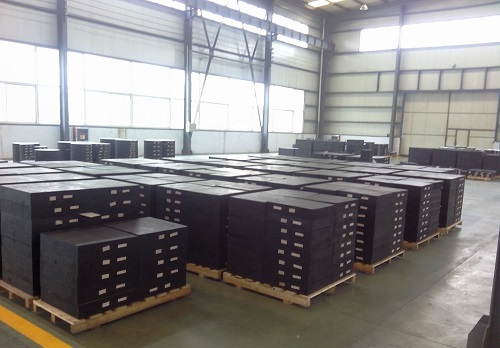Bridge Rubber Bearing Pads Production
The rubber bearing pads is made of at least two layers of rubber with the same thickness, with reinforce steel plates embedding, bonding, vulcanization together.
1.The rubber material testing of rubber bearing pads
Before the vulcanization, the rubber material needed to be mixing, cutting to suitable pieces, and the important process is to test the rubber material before vulcanization. Normally, in the international standards,like EN1337, ASTMD4014, and other international standards in different areas and countries, there are strict requests of rubber material technical parameter, and the requests is about the process testing, it is before vulcanization of the rubber bearing pads, not after the vulcanization. The main technical parameters of rubber materials and requests are as bellowing:
1) , Material-"Neoprene", or “Natural rubber ’ (100% virgin chloroprene or natural rubber);
2) , Elongation at break ≥400%;
3), The compressive strain of any layer shall not exceed 7% at 5.5N/mm2 average unit pressure;
4), The hardness shall be 70 durometers; and the tensile strength must be bigger than 16 Mpa.
5), The shear resistance shall not exceed 0.75N/mm2 at 25% strain of the total effective rubber thickness after an extended four(4) day ambient temperature of-29C.
6), Ozone Aging should under condition of 50pphm, 20%Elongation, 40℃×48h.
2.Molds Making Of The Rubber Bearing Pad
Make suitable molds to shape rubber sheets and steel plates according to specific sizes and shapes of bridge bearing pad,
We have molds store area for all rubber bearings, such as bridge rubber bearing, lead core rubber bearing, HDRB, for different dimensions and shapes, some of them are standard dimensions and types, some of them are customized types for clients.
3. The vulcanization of bridge rubber bearing pads
Put the mixed rubber sheets and steel plates into the mold and bond them through high-temperature vulcanization. The vulcanization process usually needs to be carried out on a flat vulcanization machine, and the specification representation method is flexible, which can be determined based on width and length.
The vulcanization process of rubber plate bearings is a crucial step that directly affects the performance and quality of the product. The following are the precautions to be taken during the vulcanization process:
1), Vulcanization temperature:
The vulcanization temperature is one of the basic conditions for rubber to undergo vulcanization reaction, which directly affects the speed and degree of vulcanization reaction. Generally speaking, the vulcanization temperature is more suitable between 140℃ and 150 ℃. Excessive temperature can cause the cracking of rubber molecular chains, leading to a decrease in the physical and mechanical properties of vulcanized rubber.
2), Vulcanization time:
The vulcanization time is closely related to the vulcanization temperature. At high temperatures, the vulcanization time can be shorter, while at low temperatures, it is necessary to extend the vulcanization time appropriately. Usually, the length of vulcanization time depends on the temperature of vulcanization, the formula of the rubber material, and the thickness of the vulcanized area. For example, optimizing the vulcanization conditions to 120 ℃ x 7 hours can significantly shorten the vulcanization time and improve production efficiency.
3),Vulcanization pressure:
The vulcanization pressure is also an important factor affecting the vulcanization effect. Appropriate pressure can help rubber sheets better bond with steel plates, thereby improving the overall stability of the structure.
4),Optimization of vulcanization process:
By calculating the vulcanization effect, equivalent vulcanization time, and degree of vulcanization of each rubber layer of the support, and optimizing the vulcanization process of the support, the utilization rate of vulcanization equipment can be significantly improved, production costs can be reduced, and product performance can be ensured to meet design requirements.
5),Thickness and number of layers:
Plate type rubber bearings are made by embedding, bonding, and vulcanizing multiple layers of rubber and thin steel plates. The required vulcanization time and temperature may vary for rubber products with different thicknesses and layers. Generally speaking, the thicker or more layers, the longer the required vulcanization time.
6), Production process:
The production process of plate rubber bearings has not yet been fully automated, and the steps before vulcanization are mostly manual operations. The quality of processes such as lamination, cutting, and stacking is closely related to the proficiency of workers. Therefore, it is necessary to provide training and assessment for workers.

Conclusion,
The production of bridge rubber bearings requires not only high-quality materials but also mature technology in terms of ingredients, testing, production and vulcanization, and finished product testing.